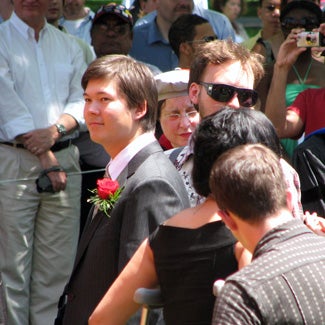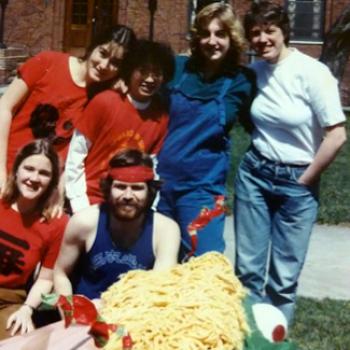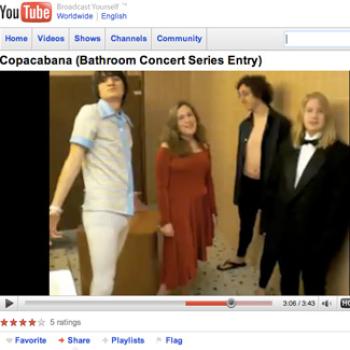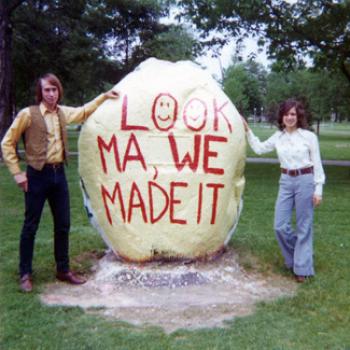On defining Oberlin
Jaremy Rich ’07
“There are thousands of attributes, numbers and statistics that you could chime off that make Oberlin marginally better or worse than any given institution...what the Princeton Review or the US News and World Report cannot calculate, however, is the Oberlin community.”

When I first applied to college in the fall of 2002, it was nearly impossible to separate one institution from another. One school might have had slightly higher average SAT scores, while another had a lower teacher-student ratio. I was inundated with numbers to the point that I could no longer comprehend one statistic from another, let alone to which college it belonged. All I knew about Oberlin College was that my college counselor attended 30 years earlier, and I’d heard it was a progressive place. When my counselor suggested I apply, I wondered: what numbers could Oberlin possibly give me to steal me away from the comfortable confines of the Northeast? It wasn’t until my Oberlin visit that I realized what was in store for me.
On my first night on campus, I was taken around by a member of the baseball team (a team I played on for four years). We made our obligatory campus walk-about, stopping in the science center, eating at the dining hall and making a pit stop for a smoothie at the student union. This was a visit I’d made at a dozen other schools, but something made it different. It was the people—students who genuinely cared about your experience on campus, who wanted to make sure you saw the best of Oberlin. I spent 15 minutes talking with the smoothie maker at Decafe (pronounced Day-caff, regardless of the accented e), chatting about life. I sat in the dining hall talking to English majors, conservatory students, and baseball players. I found people who were wonderfully passionate about a multitude of subjects, not content just to stand around and watch the world pass them by.
I began to realize that Oberlin students refuse to settle. In my brief trip, I was even lectured by a passerby that the best smoothies were made using half-yogurt and half-juice. He would not settle for an imperfect smoothie, and he didn’t want me to either. (I still only get smoothies with half-yogurt and half-juice, and I have the Decafe smoothie recipe, as printed by The Morning Journal, posted on my refrigerator. All other smoothies are inferior.) Oberlin students believe in changing the world one step, one person at a time. When I applied, the school’s slogan read: “Think one person can change the world? So do we.” I still live by that tenet. I stood in line for 6 hours to vote in the 2004 election, standing alongside 3,000 other students who believe they could make a difference.
There are thousands of attributes, numbers and statistics that you could chime off that make Oberlin either marginally better or marginally worse than any given institution. Class size, diversity, average high school GPA. What the Princeton Review or the US News and World Report cannot calculate, however is the Oberlin community. It is Oberlin’s student body and its faculty that set it apart from other colleges. It is an idea and a set of ideals that cannot be quantified or added together, but must be seen, felt, experienced. How can you measure the experience of being taught swing dancing in an Oberlin ExCo or learning bowling from the legendary Tom Reid? How do you quantify engaging discussions at 4 a.m. sitting on “Mount Oberlin” in the middle of Winter Term?
It is absolutely fitting that not only did I fall in love with Oberlin, but I fell in love at Oberlin, with a girl who I will marry next fall at Fairchild Chapel—the place where I first saw the Obertones, next door to the building where I took geology with Bruce Simonson. It says something that many Obies often find love together—we’re a unique, quirky and passionate bunch, and we all want to change the world together. Even though we met in calculus class, it wasn’t the numbers, statistics, derivatives or integrals that brought us together. It was a feeling—an internal sense that something was right. When I visited Oberlin, just as when I met my first truly close friends in Barrows freshman year, I just knew, and no set of numbers or statistics could reinforce or disparage that feeling.
Tags:
You may also like

On the Asia House dragon
“It would have been tedious work except that it was ambitious, self-directed, and had nothing to do with classes or credits. What made it something to look forward to was the enjoyment of working...
Bill Heinrich ’81

On making a video for an Ellen DeGeneres Show contest
“I had only known these people for a couple of months, and I was not only asking them to dance and sing in a public place, but I was also potentially asking them to do it on national television (if...
Amanda Nichols ’12

On the influence of an Oberlin education
“Oberlin was not simply a 4-year stopping point, but has been and continues to be an essential part of my journey. It taught me to be ever vigilant in seeking social justice, curious, caring, open to...
Elizabeth Taylor Quilliam ’74